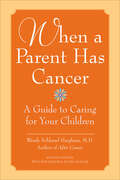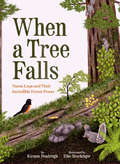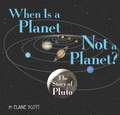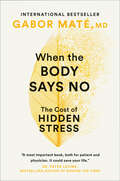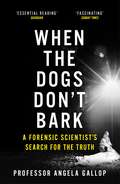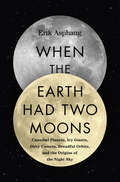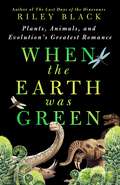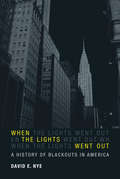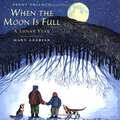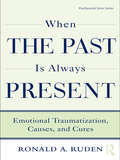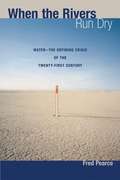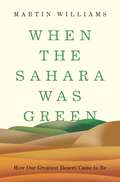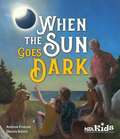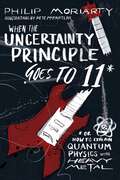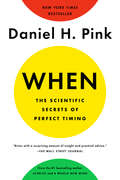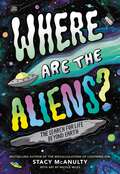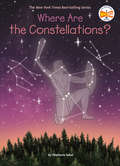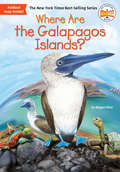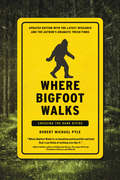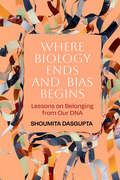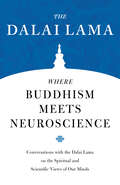- Table View
- List View
When a Parent Has Cancer: A Guide to Caring for Your Children
by Wendy Schlessel HarphamAt some point in our lives, many of us will face the crisis of an unexpected illness. For parents, the fear, anxiety and confusion resulting from a cancer diagnosis can be particularly devastating. When A Parent Has Cancer is a book for families written from the heart of experience. A mother, physician, and cancer survivor, Dr Wendy Harpham offers clear, direct, and sympathetic advice for parents challenged with the task of raising normal, healthy children while they struggle with a potentially life–threatening disease. Dr Harpham lays the groundwork of her book with specific plans for helping children through the upheaval of a parent's diagnosis and treatment, remission and recovery, and if necessary, confronting the possibility of death. She emphasises the importance of being honest with children about the gravity of the illness, while assuring them that their basic needs will always be met. Included is Becky and the Worry Cup, an illustrated children's book that tells the story of a seven–year–old girl's experiences with her mother's cancer.
When a Tree Falls: Nurse Logs and Their Incredible Forest Power
by Kirsten PendreighThe perfect read for exploring nature with children, this beautiful nonfiction picture book offers an awe-inspiring look at the forest’s life cycle.A tree suns and sways in the forest. She is a place to grow, to rest, and to shelter. But what happens when a tree falls? The answer will make your heart soar.In this lyrical picture book, explore how the extraordinary nurse log provides a nutrient-rich space for new seedlings, shelters small animals, hosts different plant species, and, most profoundly, nurtures a new tree in the process, renewing the cycle of life. Young readers will be amazed by the nurse log’s resilience and its powerful connection to the forest’s past, present, and future.BOOK ABOUT TREES & MUCH MORE: Every organism in the forest ecosystem is connected. This fascinating picture book powerfully illustrates how the end of one life in the forest can be the beginning of another.FOR LOVERS OF NATURE: When a Tree Falls is a reminder of the wondrous ecosystems in our own backyards and the wild forest beauty we may discover by looking closely. It is ideal for families who enjoy being in nature. LUSH ILLUSTRATIONS: The forest life is rendered with such richness and detail that it invites readers to immerse themselves in the endlessly inspiring natural world.GORGEOUS GIFT: An excellent choice for a classroom book or as a gift for kids who love trees, spending time outdoors, and are mindful of environmental issues.Perfect for:Kids who are interested in trees and forestsParents and grandparents of children who want to learn more about trees and forestsTeachers, educators, and librarians seeking beautiful nonfiction books with STEM contentGift-givers looking for a distinctive present for an animal- or nature-loving childAnyone seeking a picture book that promotes environmental awarenessReaders of Because of an Acorn, Over and Under the Rainforest, and Wake Up, Woodlands
When is a Planet Not a Planet?: The Story of Pluto
by Elaine ScottSpace and planets are topics of endless fascination to kids and part of every grade-school curriculum. Yet because of the history-making reassignment of Pluto from "planet" to "dwarf planet" on August 24, 2006, all books on the solar system are now out of date. Enter When is a Planet Not a Planet? The Story of Pluto by Elaine Scott, an esteemed writer of non-fiction for children. Scott is the first to put the answer to the title question into terms simple enough for a very young audience to understand, based upon the new definitions determined by the International Astronomical Union. Well-researched and accompanied by large, awe-inspiring photographs and paintings, this exciting new book makes clear what astronomers have argued about for decades. Image descriptions present.
When the Body Says No: The Cost of Hidden Stress
by Gabor MateIn this accessible and groundbreaking book -- filled with the moving stories of real people -- medical doctor and bestselling author of Scattered Minds, Gabor Maté, shows that emotion and psychological stress play a powerful role in the onset of chronic illness. Western medicine achieves spectacular triumphs when dealing with acute conditions such as fractured bones or life-threatening infections. It is less successful against ailments not susceptible to the quick ministrations of scalpel, antibiotic or miracle drug. Trained to consider mind and body separately, physicians are often helpless in arresting the advance of most of the chronic diseases, such as breast cancer, rheumatoid arthritis, Crohn's disease, multiple sclerosis, fibromyalgia, and even Alzheimer's disease. Gabor Maté has found that in all of these chronic conditions, there is a common thread: people afflicted by these diseases have led lives of excessive stress, often invisible to the individuals themselves. From an early age, many of us develop a psychological coping style that keeps us out of touch with the signs of stress. So-called negative emotions, particularly anger, are suppressed. Dr. Maté writes with great conviction that knowledge of how stress and disease are connected is essential to prevent illness in the first place, or to facilitate healing. <p><p> When the Body Says No is an impressive contribution to current research on the physiological connection between life's stresses and emotions and the body systems governing nerves, immune apparatus and hormones. With great compassion and erudition, Gabor Maté demystifies medical science and, as he did in Scattered Minds, invites us all to be our own health advocates.
When the Dogs Don't Bark: A Forensic Scientist's Search for the Truth
by Professor Angela Gallop*As seen on ITV's The Pembrokeshire Murders*'Fascinating. A book that will be essential reading for every aspiring crime writer' Guardian'Offers a chilling glimpse into her life's work. Fascinating stuff.' Sunday Times 'Compelling' Daily Mirrror__________By the time I arrived at the wood yard in Huddersfield on a bitterly cold night in February 1978, the body of the 18-year-old victim had already been taken to the mortuary.__________Never before has criminal justice rested so heavily on scientific evidence. With ever-more sophisticated and powerful techniques at their disposal, forensic scientists have an unprecedented ability to help solve even the most complex cases. Angela Gallop has been a forensic scientist for over 40 years. After joining the Forensic Science Service, the first crime scene she attended was for a case involving the Yorkshire Ripper. As well as working on a wide range of cases in many countries around the world, she is now the most sought-after forensic scientist in the UK, where she has helped solve numerous high-profile cases, including the investigation that finally absolved the Cardiff Three the Pembrokeshire Coastal Path murders, and the killings of Stephen Lawrence, Damilola Taylor, Rachel Nickell and Roberto Calvi. From the crime scene to the courtroom, When the Dogs Don't Bark is the remarkable story of a life spent searching for the truth.'Fascinating' The Sun'a casebook that reads like The Encyclopedia Of Murder' Daily Express'One of the profession's leading lights' Woman & Home'The real life Silent Witness' Belfast Telegraph__________The compelling memoir from the UK's most eminent forensic scientist and some of the most fascinating criminal investigations she has worked on. You learnt about forensic pathology with Dr Richard Shepherd in Unnatural Causes and about anthropology with Professor Sue Black in All That Remains. Now it's time to learn about the scene of the crime. . .
When the Earth Had Two Moons: Cannibal Planets, Icy Giants, Dirty Comets, Dreadful Orbits, and the Origins of the Night Sky
by Erik AsphaugAn astonishing exploration of planet formation and the origins of life by one of the world’s most innovative planetary geologists.In 1959, the Soviet probe Luna 3 took the first photos of the far side of the moon. Even in their poor resolution, the images stunned scientists: the far side is an enormous mountainous expanse, not the vast lava-plains seen from Earth. Subsequent missions have confirmed this in much greater detail.How could this be, and what might it tell us about our own place in the universe? As it turns out, quite a lot.Fourteen billion years ago, the universe exploded into being, creating galaxies and stars. Planets formed out of the leftover dust and gas that coalesced into larger and larger bodies orbiting around each star. In a sort of heavenly survival of the fittest, planetary bodies smashed into each other until solar systems emerged. Curiously, instead of being relatively similar in terms of composition, the planets in our solar system, and the comets, asteroids, satellites and rings, are bewitchingly distinct. So, too, the halves of our moon.In When the Earth Had Two Moons, esteemed planetary geologist Erik Asphaug takes us on an exhilarating tour through the farthest reaches of time and our galaxy to find out why. Beautifully written and provocatively argued, When the Earth Had Two Moons is not only a mind-blowing astronomical tour but a profound inquiry into the nature of life here—and billions of miles from home.
When the Earth Was Green: Plants, Animals, and Evolution's Greatest Romance
by Riley BlackWinner, A Friend of Darwin Award, 2024 A gorgeously composed look at the longstanding relationship between prehistoric plants and life on EarthFossils plants allow us to touch the lost worlds from billions of years of evolutionary backstory. Each petrified leaf and root show us that dinosaurs, saber-toothed cats, and even humans would not exist without the evolutionary efforts of their leafy counterparts. It has been the constant growth of plants that have allowed so many of our favorite, fascinating prehistoric creatures to evolve, oxygenating the atmosphere, coaxing animals onto land, and forming the forests that shaped our ancestors’ anatomy. It is impossible to understand our history without them. Or, our future.Using the same scientifically-informed narrative technique that readers loved in the award-winning The Last Days of the Dinosaurs, in When the Earth Was Green, Riley Black brings readers back in time to prehistoric seas, swamps, forests, and savannas where critical moments in plant evolution unfolded. Each chapter stars plants and animals alike, underscoring how the interactions between species have helped shape the world we call home. As the chapters move upwards in time, Black guides readers along the burgeoning trunk of the Tree of Life, stopping to appreciate branches of an evolutionary story that links the world we know with one we can only just perceive now through the silent stone, from ancient roots to the present.
When the Invasion of Land Failed: The Legacy of the Devonian Extinctions (The Critical Moments and Perspectives in Earth History and Paleobiology)
by George McGhee Jr.The invasion of land by ocean-dwelling plants and animals was one of the most revolutionary events in the evolution of life on Earth, yet the animal invasion almost failed—twice—because of the twin mass extinctions of the Late Devonian Epoch. Some 359 to 375 million years ago, these catastrophic events dealt our ancestors a blow that almost drove them back into the sea. If those extinctions had been just a bit more severe, spiders and insects—instead of vertebrates—might have become the ecologically dominant forms of animal life on land. This book examines the profound evolutionary consequences of the Late Devonian extinctions and the various theories proposed to explain their occurrence. Only one group of four-limbed vertebrates exists on Earth, while other tetrapod-like fishes are extinct. This gap is why the idea of "fish with feet" seems so peculiar to us, yet such animals were once a vital part of our world, and if the Devonian extinctions had not happened, members of these species, like the famous Acanthostega and Ichthyostega, might have continued to live in our rivers and lakes. Synthesizing decades of research and including a wealth of new discoveries, this accessible, comprehensive text explores the causes of the Devonian extinctions, the reasons vertebrates were so severely affected, and the potential evolution of the modern world if the extinctions had never taken place.
When the Land Was Young: Reflections on American Archaeology
by Sharman Apt RussellRussell, author of "Kill the Cowboy", focuses on the idea that there are multiple ways of examining the past. She interviews an array of characters who have been instrumental in reshaping modern archaeology and speaks to those who continue to wrestle with the nature of the field today.
When the Lights Went Out: A History of Blackouts in America (The\mit Press Ser.)
by David E. NyeBlackouts—whether they result from military planning, network failure, human error, or terrorism—offer snapshots of electricity's increasingly central role in American society.Where were you when the lights went out? At home during a thunderstorm? During the Great Northeastern Blackout of 1965? In California when rolling blackouts hit in 2000? In 2003, when a cascading power failure left fifty million people without electricity? We often remember vividly our time in the dark. In When the Lights Went Out, David Nye views power outages in America from 1935 to the present not simply as technical failures but variously as military tactic, social disruption, crisis in the networked city, outcome of political and economic decisions, sudden encounter with sublimity, and memories enshrined in photographs. Our electrically lit-up life is so natural to us that when the lights go off, the darkness seems abnormal. Nye looks at America's development of its electrical grid, which made large-scale power failures possible and a series of blackouts from military blackouts to the “greenout” (exemplified by the new tradition of “Earth Hour”), a voluntary reduction organized by environmental organizations. Blackouts, writes Nye, are breaks in the flow of social time that reveal much about the trajectory of American history. Each time one occurs, Americans confront their essential condition—not as isolated individuals, but as a community that increasingly binds itself together with electrical wires and signals.
When the Moon is Full: A Lunar Year (Into Reading, Trade Book #6)
by Mary Azarian Penny PollockNIMAC-sourced textbook <p><p> A lunar guide describes the folkloric names of twelve moons according to Native American tradition and showcases their defining characteristics in short verse and beautifully detailed hand-colored woodcuts.
When the Past is Always Present: Emotional Traumatization, Causes, and Cures (Psychosocial Stress Series)
by Ronald A. RudenWhen the Past Is Always Present: Emotional Traumatization, Causes, and Cures introduces several new ideas about trauma and trauma treatment. The first of these is that another way to treat disorders arising from the mind/brain may be to use the senses. This idea, which is at the core of psychosensory therapy, forms what the author considers the "third pillar" of trauma treatment (the first and second pillars being psychotherapy and psychopharmacology). Psychosensory therapy postulates that sensory input for example, touch creates extrasensory activity that alters brain function and the way we respond to stimuli. The second idea presented in this book is that traumatization is encoded in the amygdala only under special circumstances. Thus, by understanding what makes an individual resistant to traumatization we can offer a way of preventing it. The third idea is that traumatization occurs because we cannot find a haven during the event. This is the cornerstone of havening, the particular form of psychosensory therapy described in the book. Using evolutionary biological principles and recently published neuroscientific studies, this book outlines in detail how havening touch de-links the emotional experience from a trauma, essentially making it just an ordinary memory. Once done, the event no longer causes distress. "
When the Phone Rang
by Harry MazerWhen their parents are killed in an airplane crash, three siblings try to keep the family together in the face of overwhelming personal and financial problems.
When the Rivers Run Dry: Water -- The Defining Crisis of the Twenty-first Century
by Fred PearceIn this groundbreaking book, veteran science correspondent Fred Pearce travels to more than thirty countries to examine the current state of crucial water sources. Deftly weaving together the complicated scientific, economic, and historic dimensions of the world water crisis, he provides our most complete portrait yet of this growing danger and its ramifications for us all. "A strong--and scary--case that a worldwide water shortage is the most fearful looming environmental crisis. With a drumbeat of facts both horrific (thousands of wells in India and Bangladesh are poisoned by fluoride and arsenic) and fascinating (it takes 20 tons of water to make one pound of coffee), the former New Scientist news editor documents a "kind of cataclysm" already affecting many of the world's great rivers." -Publishers Weekly, starred review. "Oil we can replace. Water we can"t-which is why this book is both so ominous and so important." -Bill McKibben, author of The End of Nature
When the Sahara Was Green: How Our Greatest Desert Came to Be
by Martin WilliamsThe little-known history of how the Sahara was transformed from a green and fertile land into the largest hot desert in the worldThe Sahara is the largest hot desert in the world, equal in size to China or the United States. Yet, this arid expanse was once a verdant, pleasant land, fed by rivers and lakes. The Sahara sustained abundant plant and animal life, such as Nile perch, turtles, crocodiles, and hippos, and attracted prehistoric hunters and herders. What transformed this land of lakes into a sea of sands? When the Sahara Was Green describes the remarkable history of Earth’s greatest desert—including why its climate changed, the impact this had on human populations, and how scientists uncovered the evidence for these extraordinary events.From the Sahara’s origins as savanna woodland and grassland to its current arid incarnation, Martin Williams takes us on a vivid journey through time. He describes how the desert’s ancient rocks were first fashioned, how dinosaurs roamed freely across the land, and how it was later covered in tall trees. Along the way, Williams addresses many questions: Why was the Sahara previously much wetter, and will it be so again? Did humans contribute to its desertification? What was the impact of extreme climatic episodes—such as prolonged droughts—upon the Sahara’s geology, ecology, and inhabitants? Williams also shows how plants, animals, and humans have adapted to the Sahara and what lessons we might learn for living in harmony with the harshest, driest conditions in an ever-changing global environment.A valuable look at how an iconic region has changed over millions of years, When the Sahara Was Green reveals the desert’s surprising past to reflect on its present, as well as its possible future.
When the Sun Goes Dark
by Andrew Fraknoi Dennis SchatzHelp youngsters understand the excitement about the recent solar eclipse with this charming and straightforward story about how eclipses of the Sun and Moon occur. Includes easy activities using ordinary items to make models, and explores common questions kids have. This richly illustrated book tells how two curious children and their grandparents re-create eclipses in their living room using a lamp, a tennis ball, two Hula Hoops, and Ping-Pong balls. Later, in the backyard and around the house, the family explores safe ways to view a solar eclipse and ponders phenomena from sunspots to phases of the Moon. Written by the authors of NSTA's award-winning book Solar Science, When the Sun Goes Dark gives children and adults hands-on techniques for learning the science behind eclipses of the Sun and Moon.
When the Uncertainty Principle Goes to 11: Or How to Explain Quantum Physics with Heavy Metal
by Philip MoriartyThere are deep and fascinating links between heavy metal and quantum physics. No, really! While teaching at the University of Nottingham, physicist Philip Moriarty noticed something odd, a surprising number of his students were heavily into metal music. Colleagues, too: a Venn diagram of physicists and metal fans would show a shocking amount of overlap. What's more, it turns out that heavy metal music is uniquely well-suited to explaining quantum principles. In When the Uncertainty Principle Goes to Eleven, Moriarty explains the mysteries of the universe's inner workings via drum beats and feedback: You'll discover how the Heisenberg uncertainty principle comes into play with every chugging guitar riff, what wave interference has to do with Iron Maiden, and why metalheads in mosh pits behave just like molecules in a gas. If you're a metal fan trying to grasp the complexities of quantum physics, a quantum physicist baffled by heavy metal, or just someone who'd like to know how the fundamental science underpinning our world connects to rock music, this book will take you, in the words of Pantera, to "A New Level." For those who think quantum physics is too mind-bendingly complex to grasp, or too focused on the invisibly small to be relevant to our full-sized lives, this funny, fascinating book will show you that physics is all around us . . . and it rocks.
When: The Scientific Secrets of Perfect Timing
by Daniel H. Pink<P>Daniel H. Pink, the #1 bestselling author of Drive and To Sell Is Human, unlocks the scientific secrets to good timing to help you flourish at work, at school, and at home. <P>Everyone knows that timing is everything. But we don't know much about timing itself. Our lives are a never-ending stream of "when" decisions: when to start a business, schedule a class, get serious about a person. Yet we make those decisions based on intuition and guesswork. <P>Timing, it's often assumed, is an art. In When: The Scientific Secrets of Perfect Timing, Pink shows that timing is really a science. <P>Drawing on a rich trove of research from psychology, biology, and economics, Pink reveals how best to live, work, and succeed. How can we use the hidden patterns of the day to build the ideal schedule? Why do certain breaks dramatically improve student test scores? How can we turn a stumbling beginning into a fresh start? Why should we avoid going to the hospital in the afternoon? Why is singing in time with other people as good for you as exercise? And what is the ideal time to quit a job, switch careers, or get married? <P>In When, Pink distills cutting-edge research and data on timing and synthesizes them into a fascinating, readable narrative packed with irresistible stories and practical takeaways that give readers compelling insights into how we can live richer, more engaged lives. <P><b>A New York Times Bestseller</b>
Where Are the Aliens?: The Search for Life Beyond Earth
by Stacy McAnultyA fun-filled, highly illustrated, science-based exploration into one of the universe&’s greatest mysteries—does life exist beyond Earth?—from bestselling and award-winning author Stacy McAnulty. Spoiler: Scientists haven&’t discovered life beyond Earth, not even a single teeny-tiny organism. But there&’s a whole lot of outer space, and humans have searched only a fraction of a fraction of it. So do you believe in the possibility of life out there? Or do you think Earth is perfectly unique in its ability to grow organisms?Where Are the Aliens? takes readers on a journey of theories and discoveries, from the big bang and primordial soup, to how the ancient Greeks considered the cosmos, to the technology used today to listen and (possibly!) communicate with far-off exoplanets. Packed with playful illustrations and fascinating factoids, this is the perfect book for anyone who has ever looked up and asked, "What's out there?"
Where Are the Constellations? (Where Is?)
by Stephanie Sabol Who HqCalling all stargazers, here is the book for you! Ancient people from many different cultures--Greek, Roman, Mezo-American, Arab--all looked up and imagined pictures in the sky by "drawing" a line from one star to another, like a connect-the-dots puzzle. These star pictures--constellations--represented myths and legends from the various cultures that still fascinate us today. Author of the tremendously popular Where Is Our Solar System? Stephanie Sabol relates many of the most popular constellation stories and explains what stars actually are: how they formed, why they die, and how they're grouped into constellation families.
Where Are the Galapagos Islands?
by Megan Stine John HinderliterArmchair adventurers can set sail for the remote Galapagos Islands and learn about the strange and unique animals that live there. The Galapagos Islands are a chain of volcanic islands located on either side of the equator in the Pacific Ocean. The isolated location of the islands has allowed a vast number of species to develop that are original to each island, such as the marine iguana, the blue-footed booby, the magnificent frigatebird and of course the giant Galapagos tortoise, which may live to be over one hundred years old. Studied by Charles Darwin during his historic voyage on the HMS Beagle, the island life contributed to his groundbreaking theory of evolution. Today the islands are a popular tourist destination and a UNESCO World Heritage site.This book, part of the New York Times best-selling series, is enhanced by eighty illustrations and a detachable fold-out map complete with four photographs on the back.From the Trade Paperback edition.
Where Bigfoot Walks: Crossing the Dark Divide
by Robert Michael PyleOne of America&’s most esteemed natural history writers takes to the hills of the Pacific Northwest in search of Bigfoot—and finds the wildness within ourselves Awarded a Guggenheim Fellowship to investigate the legends of Sasquatch, Yale–trained ecologist Dr. Robert Pyle treks into the unprotected wilderness of the Dark Divide near Mount St. Helens, where he discovers both a giant fossil footprint and recent tracks. On the trail of what he thought was legend, he searches out Indians who tell him of an outcast tribe, the Seeahtiks, who had not fully evolved into humans. A handful of open–minded biologists and anthropologists counter the tabloids Pyle studies, while rogue Forest Service employees and loggers swear of a vast conspiracy to deep–six true stories of unknown, upright hominoid apes among us. He attends Sasquatch Daze, where he meets scientists, hunters, and others who have devoted their lives to the search, only to realize that &“these guys don't want to find Bigfoot―they want to be Bigfoot!&” Where Bigfoot Walks was the inspiration for the 2020 film The Dark Divide, starring David Cross and Debra Messing. Since the book&’s original publication, Pyle&’s fresh experiences and findings have been added to his original work through an updated chapter. With an evaluation of recent DNA evidence from Bigfoot hair and scat, the study of speech phonemes in the &“Sierra Sounds&” purported Bigfoot recordings, an examination of the impact of the wildly popular Animal Planet series Bigfoot Hunters, the reemergence of the famous Bob Gimlin into the Bigfoot community, and more, Walking With Bigfoot keeps every Bigfoot enthusiast&’s mind wide open to one of the biggest questions in the land and brings Pyle&’s work on the &“legend&” of Bigfoot into the new century.
Where Biology Ends and Bias Begins: Lessons on Belonging from Our DNA
by Shoumita DasguptaA geneticist and internationally recognized anti-racism educator provides a powerful, science-based rebuttal to common fallacies about human difference. Well-meaning physicians, parents, and even scientists today often spread misinformation about what biology can and can’t tell us about our bodies, minds, and identities. In this accessible, myth-busting book, geneticist Shoumita Dasgupta draws on the latest science to correct common misconceptions about how much of our social identities are actually based in genetics. Dasgupta weaves together history, current affairs, and cutting-edge science to break down how genetic concepts are misused and how we can approach scientific evidence in a socially responsible way. With a unifying and intersectional approach disentangling biology from bigotry, the book moves beyond race and gender to incorporate categories like sexual orientation, disability, and class. Where Biology Ends and Bias Begins is an invaluable, empowering resource for biologists, geneticists, science educators, and anyone working against bias in their community.
Where Buddhism Meets Neuroscience: Conversations with the Dalai Lama on the Spiritual and Scientific Views of Our Minds (Core Teachings of Dalai Lama #6)
by The Dalai LamaThis book, designed as a conversation between the Dalai Lama and Western neuroscientists, takes readers on a journey through opposing fields of thought--showing that they may not be so opposing after all.Is the mind an ephemeral side effect of the brain’s physical processes? Are there forms of consciousness so subtle that science has not yet identified them? How does consciousness happen? Organized by the Mind and Life Institute, this discussion addresses some of the most troublesome questions that have driven a wedge between Western science and religion. Edited by Zara Houshmand, Robert B. Livingston, and B. Alan Wallace, Where Buddhism Meets Neuroscience is the culmination of meetings between the Dalai Lama and a group of eminent neuroscientists and psychiatrists. The Dalai Lama’s incisive, open-minded approach both challenges and offers inspiration to Western scientists. This book was previously published under the title Consciousness at the Crossroads.
Where Did I Come From?
by Peter MayleHow do you define penis and vagina and their functions to a seven year old? How do you explain the process and pleasure of conception? How does the baby start growing and how does it get out of its mother? How much should you tell and what should you skip?-And how do you tell it so that it interests your child and doesn't embarrass you?. It covers all the bases. From love-making, orgasm, conception and growth inside the womb through the actual birth day. It names all the labels (vagina, penis, etc.) and shows all the important parts of the body. In other words, WHERE DID I COME FROM? treats your child like a young adult. Which, after all, is what he or she is.The information isn't too clinical or detailed. It's told with warmth. The validator has described the many illustrations carefully so blind children and parents will have access to all of them. For example the text describes and the pictures illustrate the development of a fetus month by month. This is a book parents can enjoy sharing with their children. The foundation it provides creates a comfortable atmosphere for them to continue to talk about where babies come from in a more personal, relaxed, way.
